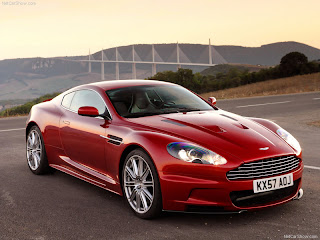Aston Martin DBS: Performance
The need for high-performance stability, handling ability and low kerb weight defined the DBS's form and construction. Accordingly, the Aston Martin DBS becomes the first production Aston Martin to make extensive use of ultra-light carbon-fibre body panels. High levels of performance and control are delivered by the combination of inherent light weight, near-perfect weight distribution, a supremely powerful and flexible V12 engine, and a performance-honed six-speed transmission, together with new carbon ceramic brakes and an adaptive damper controlled suspension system.
At the heart of the Aston Martin DBS is a 6.0-litre V12 engine. The DBR9 and
DBRS9 race cars are powered by an enhanced version of this same V12, tuned to produce in excess of 600bhp. The shared powerplant continues the strong link between Aston Martin's road and race cars, just as the six-cylinder engine used in the DBR1 also powered the
Aston Martin DB4,
DB5 and
DB6 in the 1950s and 60s.
As with all current Aston Martins, the engine is hand-assembled at Aston Martin's dedicated engine facility in Cologne, Germany. The classic 6.0-litre V12 features a number of power-increasing enhancements. These include a 'by-pass' engine air intake port that opens above 5500rpm to allow more air into the engine, and re-profiled air inlet ports that further improve airflow into the combustion chamber. Combined with a compression ratio of 10.9:1, the result of these enhancements is prodigious power and torque: the Aston Martin DBS delivers 380 kW (510 bhp/517 PS) at 6500 rpm. The 3.71:1 final-drive ratio ensures that the additional power is usable, enhancing in-gear acceleration in particular.

A lightweight, rigid structure is the design engineer's ultimate goal, and achieving the right balance between strength and mass is crucial. Like the DB9 and its sibling DBR9 and DBRS9 race cars, the DBS uses Aston Martin's class-leading all-alloy VH (Vertical Horizontal) architecture, a lightweight bonded aluminium structure that provides outstanding strength and rigidity. Aston Martin's engineers have also employed advanced materials and processes to further reduce weight and increase the Aston Martin DBS's performance and dynamics.

Carbon-fibre panels are used for the boot enclosure, boot lid, door opening surrounds, front wings and bonnet, giving a saving of some 30kg over more conventional materials without any reduction in strength. "There are no restrictions on form or shape in using carbon-fibre," says Marek Reichman, Aston Martin's Design Director, "and the material allowed us to wrap bodywork around the 20" wheels and maintain the precise relationship between the wheel and the bodywork."
Each panel has been carefully sculpted to direct the airflow around the car, into the engine and to help cool the braking system. The carbon-fibre elements are produced using advanced manufacturing techniques developed from the aerospace and motorsport industries.
The new panel-making procedure also delivers an industry-best surface finish, thanks to a patented 'Surface Veil' process. The application of a 200 micron layer of epoxy and glass to the panel delivers a class-A surface that is in line with Aston Martin's tradition of high-quality finishes. Inside the car, the weave patterns on the exposed carbon-fibre elements have been carefully selected to present the most harmonious surfaces.























